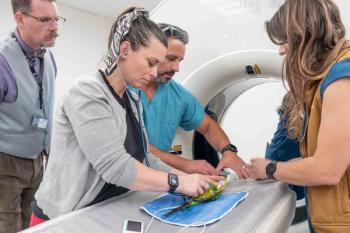
Chemoembolization for nonresectable liver tumors
A novel veterinary treatment offers hope for these often hopeless cases.
Currently, no effective treatments exist for veterinary patients with nonresectable liver cancer. Because of poor responses or complications with systemic chemotherapy and radiation therapy, veterinary oncologists typically treat these patients with supportive care.
Similar treatment difficulties in people with nonresectable hepatocellular carcinomas have led to investigation into regional, or liver-directed, therapies including intra-arterial chemotherapy delivery, transarterial embolization (TAE), transarterial chemoembolization (TACE) and ablation therapies (typically chemical or thermal).
TACE involves placing a small catheter in the femoral artery. Under fluoroscopic guidance, the catheter is advanced up the aorta and into the hepatic artery feeding the tumor, and a full dose of systemic chemotherapy and embolic particles or microspheres is injected to obstruct blood flow to the tumor. More recently, the development of drug-eluting beads has enabled 100 to 400 times the concentration of chemotherapy to be achieved within the tumor compared with the same dose given intravenously (systemically). See how this experimental therapy helped this terrier.
Initial findings
- Signalment: 7-year-old male spayed American Staffordshire terrier mix (13 kg)
- Presenting complaint: Slight lethargy, decreased appetite
- Pertinent history: No significant previous medical history until three weeks prior to presentation when abdominal exploratory surgery was performed for evaluation of a liver mass—biopsy results were consistent with a nonresectable, massive, low-grade hepatocellular carcinoma
- Medications: Milk thistle, s-adenosylmethionine
- Physical examination findings: Bright, alert and responsive; body condition score 4/9; distended abdomen with no fluid wave but palpable firm mass in cranial abdomen
Diagnostic evaluation
- Complete blood count: White blood cells = 16,600; neutrophils = 13,200; platelets = 410,000
- Serum chemistry profile: Alanine transaminase = 1,134; aspartate aminotransferase = 596; alkaline phosphatase = 980
- Bile acids: Resting = 15; Postprandial = 26
- Coagulation screen: Normal
- Thoracic radiography: Thorax normal, hepatomegaly
- Abdominal ultrasonography: Large, cavitated right-sided hepatic mass abutting diaphragm and caudal vena cava
- Computed tomography (CT) angiography: Heterogeneous right-sided massive liver tumor with portal vein and caudal vena cava compression (Figure 1)
Figure 1: CT angiograms taken before chemoembolization: 1A) Sagittal reconstruction of the abdomen with the dashed black line outlining the massive hepatocellular carcinoma compressing the caudal vena cava. 1B) Coronal reconstruction of the abdomen with the dashed black line outlining the massive hepatocellular carcinoma compressing the portal vein. (Images courtesy of Allyson Berent and Chick Weisse)
Treatment decisions
This patient had undergone previous abdominal surgery in which the nonresectable liver mass was biopsied. The surgery report described the mass as adhered to the portal vein, pancreas and bile duct, originating from the base of the liver and attaching to the body wall, right lateral and quadrate liver lobes and gallbladder. Biopsy results at that time were consistent with a well-differentiated hepatocellular carcinoma. Since these tumors demonstrate poor biological responses to systemic chemotherapy and radiation of the liver is not performed, historical standard therapy involves benign neglect and supportive care until these tumors either metastasize or, more commonly, rupture.
A CT angiogram (Figure 1) indicated that this patient was a good candidate for the drug-eluting bead TACE procedure, which was performed the next day. A combination of 1 ml of drug-eluting beads was mixed with doxorubicin (30 mg/m2) to allow the beads to absorb the chemotherapy. A 2- to 3-cm surgical incision was made in the groin to permit the placement of a vascular sheath within the femoral artery. A catheter was advanced under fluoroscopic guidance into the celiac artery. Superselective access was gained by using a 2.4-Fr microcatheter in order to minimize nontarget (normal liver parenchyma) embolization and to achieve maximal concentrations of chemotherapy and drug-eluting beads within the actual tumor.
Figure 2 is a digital subtraction arteriogram of the contributing right hepatic artery illustrating vascularization of the right-sided liver tumor before (Figure 2A) and after (Figure 2B) chemoembolization. After delivery of the drug-eluting beads, less blood supply to the tumor was seen.
Figure 2: Hepatic arteriograms from the first TACE procedure: 2A) A hepatic arteriogram taken before chemoembolization demonstrating considerable vascularization of the tumor outlined by a dashed black line. 2B) A hepatic arteriogram taken after the TACE procedure demonstrating reduced vascularity.
The dog recovered uneventfully and was discharged from the hospital the next day with prednisone, amoxicillin-clavulanate, tramadol, ondansetron and omeprazole. The results of repeat complete blood counts one, two and three weeks after the TACE procedure were unremarkable.
The procedure was repeated six weeks later. Figure 3 demonstrates the same superselection and microcatheter location before (Figure 3A) and after (Figure 3B) the second chemoembolization procedure. Note the smaller, more consolidated liver mass on this angiogram compared with Figure 2.
Figure 3: Hepatic arteriograms from the second TACE procedure. 3A) A hepatic arteriogram taken before chemoembolization demonstrating considerable vascularization of the now-diminished tumor outlined by a dashed black line. 3B) A hepatic arteriogram taken after the TACE procedure demonstrating reduced vascularity. Note the smaller mass compared with the prior arteriogram (Figure 2).
At the time of the second treatment, a repeat CT angiogram demonstrated about 25 percent tumor size reduction (Figure 4), and the animal was doing well clinically. These procedures can be repeated as needed. Follow-up phone calls each week confirmed that the dog continued to do well. Complete blood counts at one, two and three weeks after each chemoembolization procedure showed no evidence of white blood cell suppression.
Figure 4: Abdominal CT (noncontrast-enhanced) scans taken before the second chemoembolization: 4A) Sagittal reconstruction of the abdomen with the dashed black line outlining the smaller hepatocellular carcinoma when compared with Figure 1A. 4B) Coronal reconstruction of the abdomen with the dashed black line outlining the smaller hepatocellular carcinoma when compared with Figure 1B.
Discussion
TACE has been shown in a number of human randomized clinical trials to be associated with prolonged survival times when compared with systemic therapies.1,2 Drug-eluting beads slowly elute the doxorubicin over weeks to months within the tumor, resulting in less toxicity to patients, most of which show no side effects from the chemotherapy (such as immunocompromise or gastrointestinal toxicoses associated with systemic delivery).3
Postembolization syndrome, which is characterized by general malaise, fever, nausea and abdominal discomfort, occurs in many people after TACE. The syndrome is generally self-limiting and well-managed with supportive care such as anti-inflammatories, antinausea medications, antibiotics, pain medications and gastroprotectants. In addition, drug-eluting bead TACE therapy has been shown to result in fewer side effects such as postembolization syndrome and better results (for large tumors) than standard chemoembolization.4 It is unclear if animals experience postembolization syndrome, but we currently treat them empirically with the same medications just in case.
A fully funded study is currently looking at the use of this technique in dogs with nonresectable liver tumors (hepatocellular carcinoma), which covers the cost of three treatments and staging during the treatment process, including CT angiography. For more information about this study, please contact us at (212) 329-8816.
A video of the TACE procedure can be viewed at
Dr. Berent is the director of Interventional Endoscopy Services in the Department of Diagnostic Imaging at The Animal Medical Center in New York City. Dr. Weisse is the director of Interventional Radiology Services in the Department of Diagnostic Imaging at The Animal Medical Center in New York City.
References
1. Llovet JM, Real MI, Montana X, et al. Arterial embolisation or chemoembolisation versus symptomatic treatment in patients with unresectable hepatocellular carcinoma: a randomised controlled trial. Lancet 2002;359(9319):1734-1739.
2. Lo CM, Ngan H, Tso WK, et al. Randomized controlled trial of transarterial lipiodol chemoembolization for unresectable hepatocellular carcinoma. Hepatology 2002;35(5):1164-1171.
3. Varela M, Real MI, Burrel M, et al. Chemoembolization of hepatocellular carcinoma with drug eluting beads: efficacy and doxorubicin pharmacokinetics. J Hepatol 2007;46(3):474-481.
4. Lammer J, Malagari K, Vogl T, et al. Prospective randomized study of doxorubicin-eluting-bead embolization in the treatment of hepatocellular carcinoma: results of the PRECISION V study. Cardiovasc Intervent Radiol 2010;33(1):41-52.
Suggested Reading
- Dyet J, Ettles D, Nicholson A, et al. Textbook of endovascular procedures. 1st ed. Philadelphia, Pa: Churchill Livingstone, 2000;357-367.
- Weisse C, Clifford CA, Holt D, et al. Percutaneous arterial embolization and chemoembolization for treatment of benign and malignant tumors in three dogs and a goat. J Am Vet Med Assoc 2002;221(10):1430-1436.
- Soulen MC. Multimodality image-guided therapy for liver tumors, in Proceedings. Soc Interventional Radiol Annual Meeting, 2003;14(2):P211-P217.
- Hemingway AP, Allison DJ. Complications of embolization: analysis of 410 procedures. Radiology 1988;166(3):669-672.
- Geschwind JH. Therapy for liver cancer by targeting energy metabolism, in Proceedings. Soc Interventional Radiol Annual Meeting, 2003;14(2):P207-P211.
Newsletter
From exam room tips to practice management insights, get trusted veterinary news delivered straight to your inbox—subscribe to dvm360.






